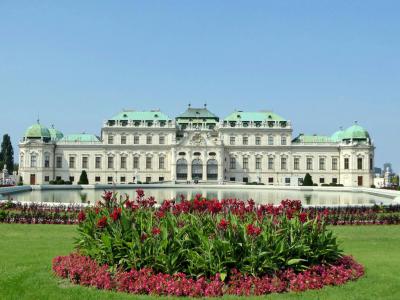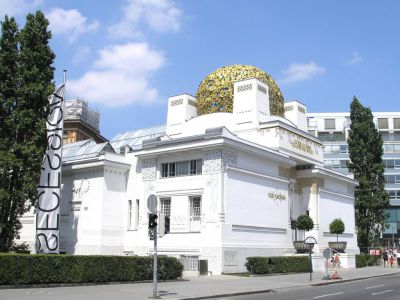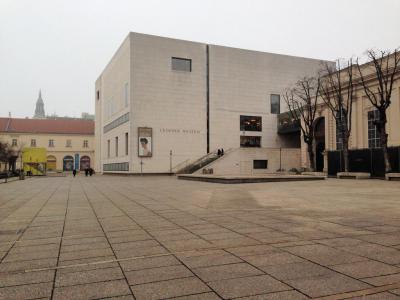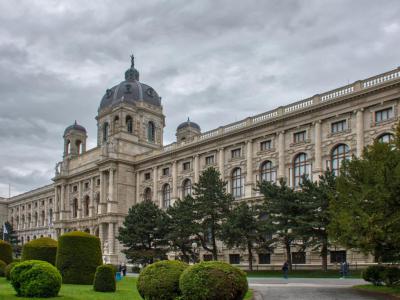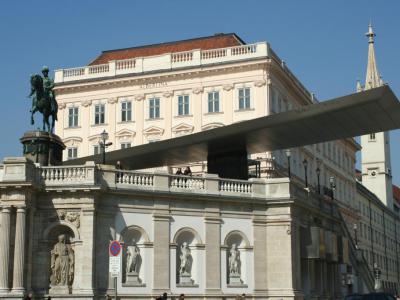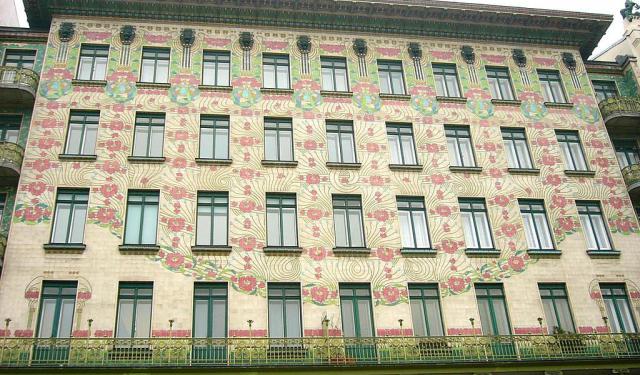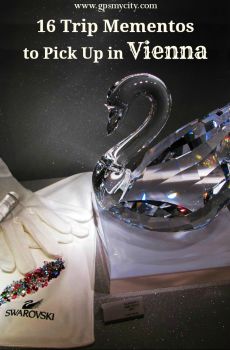
Klimt Paintings Tour (Self Guided), Vienna
"I have the gift of neither the spoken nor the written word, especially if I have to say something about myself or my work. Whoever wants to know something about me - as an artist, the only notable thing - ought to look carefully at my pictures" – Gustav Klimt.
Klimt's name is indelibly linked to Vienna. The renowned symbolist painter was a prominent figure in the city. As a founding member of the Vienna Secession movement, he resisted the conventions of the national art establishment and became widely influential in the Jugendstil (Art Nouveau) style.
Although Klimt himself lived a rather secluded life, his paintings snatched such critical accolades as the first prize at the 1911 International Exhibition of Art in Rome. Often more impressive when viewed in real life, the majority of Klimt's works today are displayed at several locations throughout Vienna.
The Belvedere Palace houses the most extensive collection of them, including the landmark "The Kiss". The Secession Building, an iconic symbol of the Vienna Secession movement, features another famous creation by Klimt, the monumental Beethoven Frieze, depicting human longing for happiness.
The Leopold Museum, home to a wealth of modern Austrian art, holds some iconic pieces by Gustav Klimt, too, such as "Death and Life", whereas the Kunsthistorisches Museum (Art History Museum), primarily known for its vast collection of European art, also showcases several Klimt paintings.
The Albertina Museum boasts a rich selection of Klimt's drawings, sketches, and graphic artworks, providing insights into the artist's creative process and exploring his mastery of various mediums.
Today, Klimt's distinctive style continues to captivate art enthusiasts worldwide. Visiting these museums offers a rich and immersive artistic journey for those seeking a comprehensive experience and deeper appreciation of Gustav Klimt.
Klimt's name is indelibly linked to Vienna. The renowned symbolist painter was a prominent figure in the city. As a founding member of the Vienna Secession movement, he resisted the conventions of the national art establishment and became widely influential in the Jugendstil (Art Nouveau) style.
Although Klimt himself lived a rather secluded life, his paintings snatched such critical accolades as the first prize at the 1911 International Exhibition of Art in Rome. Often more impressive when viewed in real life, the majority of Klimt's works today are displayed at several locations throughout Vienna.
The Belvedere Palace houses the most extensive collection of them, including the landmark "The Kiss". The Secession Building, an iconic symbol of the Vienna Secession movement, features another famous creation by Klimt, the monumental Beethoven Frieze, depicting human longing for happiness.
The Leopold Museum, home to a wealth of modern Austrian art, holds some iconic pieces by Gustav Klimt, too, such as "Death and Life", whereas the Kunsthistorisches Museum (Art History Museum), primarily known for its vast collection of European art, also showcases several Klimt paintings.
The Albertina Museum boasts a rich selection of Klimt's drawings, sketches, and graphic artworks, providing insights into the artist's creative process and exploring his mastery of various mediums.
Today, Klimt's distinctive style continues to captivate art enthusiasts worldwide. Visiting these museums offers a rich and immersive artistic journey for those seeking a comprehensive experience and deeper appreciation of Gustav Klimt.
How it works: Download the app "GPSmyCity: Walks in 1K+ Cities" from Apple App Store or Google Play Store to your mobile phone or tablet. The app turns your mobile device into a personal tour guide and its built-in GPS navigation functions guide you from one tour stop to next. The app works offline, so no data plan is needed when traveling abroad.
Klimt Paintings Tour Map
Guide Name: Klimt Paintings Tour
Guide Location: Austria » Vienna (See other walking tours in Vienna)
Guide Type: Self-guided Walking Tour (Sightseeing)
# of Attractions: 5
Tour Duration: 2 Hour(s)
Travel Distance: 3.7 Km or 2.3 Miles
Author: leticia
Sight(s) Featured in This Guide:
Guide Location: Austria » Vienna (See other walking tours in Vienna)
Guide Type: Self-guided Walking Tour (Sightseeing)
# of Attractions: 5
Tour Duration: 2 Hour(s)
Travel Distance: 3.7 Km or 2.3 Miles
Author: leticia
Sight(s) Featured in This Guide:
- Belvedere Palace
- Secessionsgebaude (Secession Building)
- Leopold Museum
- Kunsthistorisches Museum (Art History Museum)
- Albertina Museum
1) Belvedere Palace (must see)
The Belvedere palaces served as the summer residence for Prince Eugene of Savoy during the 18th century. They were designed and constructed by the renowned Baroque architect Johann Lucas von Hildebrandt. This architectural ensemble includes the Upper and Lower Belvedere buildings, along with the Orangery and Palace Stables, surrounded by extensive gardens. Recognized as one of Europe's most impressive Baroque landmarks, it has earned a place on the UNESCO World Heritage List.
Presently, the Belvedere houses an extensive collection of Austrian art spanning from the Middle Ages to contemporary times, featuring both domestic and international artists. The Upper Belvedere not only showcases artworks spanning over five centuries but also offers the opportunity to explore its splendid staterooms.
The art collection at the Belvedere offers a comprehensive overview of Austria's artistic evolution, providing valuable insights into the nation's history. The Upper Belvedere is home to the world's largest collection of Gustav Klimt's paintings, including iconic pieces like "The Kiss" (1908/09) and "Judith" (1901), as well as works by Egon Schiele and Oskar Kokoschka. Additionally, the museum boasts significant holdings of French Impressionist art and the most extensive collection of Viennese Biedermeier art, making it a must-visit cultural destination.
Why You Should Visit:
As well as being home to some of Klimt's most famous creations, the collection, in general, is vast and the building itself is remarkable.
Not only is the building a sight to behold but the grounds are magnificently maintained too, just as you would expect them to be.
Tip:
To wait in a shorter line, purchase your tickets online in advance.
Make sure to leave the time to stroll through the gardens either on the way to or from this wonderful palace.
Presently, the Belvedere houses an extensive collection of Austrian art spanning from the Middle Ages to contemporary times, featuring both domestic and international artists. The Upper Belvedere not only showcases artworks spanning over five centuries but also offers the opportunity to explore its splendid staterooms.
The art collection at the Belvedere offers a comprehensive overview of Austria's artistic evolution, providing valuable insights into the nation's history. The Upper Belvedere is home to the world's largest collection of Gustav Klimt's paintings, including iconic pieces like "The Kiss" (1908/09) and "Judith" (1901), as well as works by Egon Schiele and Oskar Kokoschka. Additionally, the museum boasts significant holdings of French Impressionist art and the most extensive collection of Viennese Biedermeier art, making it a must-visit cultural destination.
Why You Should Visit:
As well as being home to some of Klimt's most famous creations, the collection, in general, is vast and the building itself is remarkable.
Not only is the building a sight to behold but the grounds are magnificently maintained too, just as you would expect them to be.
Tip:
To wait in a shorter line, purchase your tickets online in advance.
Make sure to leave the time to stroll through the gardens either on the way to or from this wonderful palace.
2) Secessionsgebaude (Secession Building)
There was a time in the early 20th century where Vienna was the center of the world for culture – the age of Gustav Klimt and the Secessionist movement's cutting-edge art. This building represents that time, not only as a geographical location but also in its architecture and, no less notably, the "Beethoven Frieze", painted by Klimt in 1902 as a commentary on Beethoven's Symphony No. 9.
Artists were seceding from the conventional art world, and while the only real painting inside is the famous frieze, the building itself, designed by architect Joseph Olbrich, contains a number of features acting as a unique statement of intent – from the the turtles that support massive plant pots on either side of the entrance to the great dome made from 2,500 gilt laurel leaves and 300+ berries, that the Viennese were quick to christen "the golden cabbage" (Olbrich wanted it to be seen as a dome of laurel, a subtle classical reference meant to celebrate the triumph of art).
Inside, the museum has a minimalist approach to portraying the exhibitions, which allows visitors to really focus on the art. The atmosphere is very calming and magical, encouraging to stop and quietly immerse yourself in the surroundings. Photos are allowed.
Why You Should Visit:
Interesting especially if you're a fan of Klimt, with the Beethoven Frieze as the biggest highlight – one of those pieces you'll never forget!
The building's façade is quite stunning as well and you can see many tourists stand across the busy main road taking pictures.
Tip:
The audio guide (DE/EN/FR/IT) is very useful here; much easier to sit and listen as you look at each section than having to read explanatory notes.
Artists were seceding from the conventional art world, and while the only real painting inside is the famous frieze, the building itself, designed by architect Joseph Olbrich, contains a number of features acting as a unique statement of intent – from the the turtles that support massive plant pots on either side of the entrance to the great dome made from 2,500 gilt laurel leaves and 300+ berries, that the Viennese were quick to christen "the golden cabbage" (Olbrich wanted it to be seen as a dome of laurel, a subtle classical reference meant to celebrate the triumph of art).
Inside, the museum has a minimalist approach to portraying the exhibitions, which allows visitors to really focus on the art. The atmosphere is very calming and magical, encouraging to stop and quietly immerse yourself in the surroundings. Photos are allowed.
Why You Should Visit:
Interesting especially if you're a fan of Klimt, with the Beethoven Frieze as the biggest highlight – one of those pieces you'll never forget!
The building's façade is quite stunning as well and you can see many tourists stand across the busy main road taking pictures.
Tip:
The audio guide (DE/EN/FR/IT) is very useful here; much easier to sit and listen as you look at each section than having to read explanatory notes.
3) Leopold Museum (must see)
The afternoon is a good time to explore at least one of the museums in the MuseumsQuartier. The light, bright Leopold Museum is a good choice as its architecture is a masterpiece unto itself, with everything from incredibly crafted Wiener Werkstatt furniture to stunning murals inside.
But you're probably interested in Vienna's "turn of the century painting" – and, indeed, here is the largest collection of Egon Schiele and Richard Gerstl paintings in the world. Of course, there are numerous Klimts and Kokoschkas as well, and it's worth coming just to sit and stare at Klimt's "Death and Life" which shows the never-ending cycle of life and death and how mankind cannot worry over the end. The Klimt section also has an authentic reproduction of his studio's antechamber and an exhibition dedicated to the life and work of his long-time companion, lover and muse, Emilie Flöge. All in all, there are more than five thousand exhibits.
In addition to being able to visit this grand exhibit of 19th- and 20th-century Austrian art, you may also want to stop by and visit the gift shop, where you can purchase replications of some of the great pieces exhibited. The building is also home to the fin-de-siècle-style Café Leopold, which is a well known night spot for people to come, have some coffee (or traditional Austrian food), and discuss history, art, and politics.
Tip:
One point of humour – look out for the diagram of Schiele's final studio, complete with on-site skittle alley.
But you're probably interested in Vienna's "turn of the century painting" – and, indeed, here is the largest collection of Egon Schiele and Richard Gerstl paintings in the world. Of course, there are numerous Klimts and Kokoschkas as well, and it's worth coming just to sit and stare at Klimt's "Death and Life" which shows the never-ending cycle of life and death and how mankind cannot worry over the end. The Klimt section also has an authentic reproduction of his studio's antechamber and an exhibition dedicated to the life and work of his long-time companion, lover and muse, Emilie Flöge. All in all, there are more than five thousand exhibits.
In addition to being able to visit this grand exhibit of 19th- and 20th-century Austrian art, you may also want to stop by and visit the gift shop, where you can purchase replications of some of the great pieces exhibited. The building is also home to the fin-de-siècle-style Café Leopold, which is a well known night spot for people to come, have some coffee (or traditional Austrian food), and discuss history, art, and politics.
Tip:
One point of humour – look out for the diagram of Schiele's final studio, complete with on-site skittle alley.
4) Kunsthistorisches Museum (Art History Museum) (must see)
Fuel up with a cup of coffee or tea and head to one of the world-class museums along the Ring. The Kunsthistorisches Museum's galleries house vast collections of fine art and antiquities, based largely on those accumulated over the centuries by generations of Habsburg monarchs. Lavishly decorated interiors, ornate cupolas and sweeping Neo-Classical stairways create a fitting setting for the treasures housed here, with many of the works on display – particularly the Old Masters (Bruegel, Rembrandt, Michelangelo, Caravaggio, Titian, etc.) – being considered among the most spectacular in the world. Not only that, but the museum is among the most visitor-friendly you're likely to visit, with comfortable sofas available in most exhibition rooms and long closing hours on Thursdays.
The galleries occupy the top three floors (although the uppermost is not nearly as extensive), with an entrance hall, shop and cloakroom below. The ground floor contains ancient objects on one side – starting with the age of the Pharaohs in Egypt, then proceeding through ancient Greece and Rome while touching on other cultures along the way – which are joined by rare Renaissance and Baroque treasures collected by and/or made for the Hapsburg monarchs on the other side. The quality and quantity of the material presented is simply astounding, but items are generally labeled simply in German, so you'll want to spring for the audio guide (available in English) to get a more detailed commentary on highlighted objects. The second gallery floor (or "1" level) houses the Picture Gallery, which is again a huge collection of just plain amazing works by every famous artist from the 17th through the 19th centuries. The top floor (or "2" level) only houses a coin and medal gallery along with what are listed as the "Vermeyen Cartoons" – a series of impressive life-sized tapestries that portray Charles V's Tunis campaign of 1535.
The museum's grand central staircase is adorned with murals by the Klimt brothers and others, which depict the history of art from ancient Egypt to Florence. Gustav Klimt's especially ornate gilded frescoes are probably his best works, although they are illustrative, which in the critical art world loses you points (indeed, they were criticized for being "too erotic"). Diagrams point out which mural was painted by which artist, and sometimes a viewing scope is provided for visitors to see them up close.
Tip:
An adult ticket entitles you to a one-time pass to the museum, as well as, the Neue Burg located at Heldenplatz, which has amazing collections of imperial armoury, historic musical instruments, etc. – well worth a visit.
The galleries occupy the top three floors (although the uppermost is not nearly as extensive), with an entrance hall, shop and cloakroom below. The ground floor contains ancient objects on one side – starting with the age of the Pharaohs in Egypt, then proceeding through ancient Greece and Rome while touching on other cultures along the way – which are joined by rare Renaissance and Baroque treasures collected by and/or made for the Hapsburg monarchs on the other side. The quality and quantity of the material presented is simply astounding, but items are generally labeled simply in German, so you'll want to spring for the audio guide (available in English) to get a more detailed commentary on highlighted objects. The second gallery floor (or "1" level) houses the Picture Gallery, which is again a huge collection of just plain amazing works by every famous artist from the 17th through the 19th centuries. The top floor (or "2" level) only houses a coin and medal gallery along with what are listed as the "Vermeyen Cartoons" – a series of impressive life-sized tapestries that portray Charles V's Tunis campaign of 1535.
The museum's grand central staircase is adorned with murals by the Klimt brothers and others, which depict the history of art from ancient Egypt to Florence. Gustav Klimt's especially ornate gilded frescoes are probably his best works, although they are illustrative, which in the critical art world loses you points (indeed, they were criticized for being "too erotic"). Diagrams point out which mural was painted by which artist, and sometimes a viewing scope is provided for visitors to see them up close.
Tip:
An adult ticket entitles you to a one-time pass to the museum, as well as, the Neue Burg located at Heldenplatz, which has amazing collections of imperial armoury, historic musical instruments, etc. – well worth a visit.
5) Albertina Museum (must see)
What better place to visit as an art lover while in Vienna? Located in the largest of the Habsburg dynasty's residential palaces, the Albertina is home to the largest and most valuable graphical collection in the world. You can look forward to priceless prints, over 65,000 water-colors and drawings, some 70,000 photographs, and pieces from all-over-the-world recognized artists, including the Old Masters: Leonardo da Vinci, Michelangelo, Raphael, Rembrandt, and others.
There are many expositions to go through, but highlights include the Batliner Collection – an extraordinary display of modernist art, where you can admire Impressionist pieces from Monet, Degas, Cézanne or Picasso, and go through other artistic movements such as Fauvism, Brücke, Cubism or Surrealism – a very good counterpoint to the Italian/Flemish masterpieces of the Kunsthistorisches Museum. Besides, if you are a big fan of Klimt and Schiele, then this is the perfect gallery for you.
Renovation has restored a number of features of the Albertina to their former glory, including the façades and the wide open central courtyard. The excellent DO & CO restaurant serves coffee, desserts and light meals while offering splendid vistas of the historical center, and the Burggarten is the perfect place to take a break. On your way to the exit, there is also a good-sized gift shop with books relevant to the artwork and artists on display, as well as souvenirs relevant to Vienna and Austria.
Why You Should Visit:
Beautiful building with a fantastic selection of artworks and art styles. Easy to get in with an online ticket (no waiting time).
The open balcony area on the top floor is an excellent place for picture taking, as it faces many of the city's historical buildings.
Tip:
Make sure you have at least 2.5 hours on your hands to check everything.
The audio guide is for all the exhibitions, so it is worth spending some extra for it.
There are many expositions to go through, but highlights include the Batliner Collection – an extraordinary display of modernist art, where you can admire Impressionist pieces from Monet, Degas, Cézanne or Picasso, and go through other artistic movements such as Fauvism, Brücke, Cubism or Surrealism – a very good counterpoint to the Italian/Flemish masterpieces of the Kunsthistorisches Museum. Besides, if you are a big fan of Klimt and Schiele, then this is the perfect gallery for you.
Renovation has restored a number of features of the Albertina to their former glory, including the façades and the wide open central courtyard. The excellent DO & CO restaurant serves coffee, desserts and light meals while offering splendid vistas of the historical center, and the Burggarten is the perfect place to take a break. On your way to the exit, there is also a good-sized gift shop with books relevant to the artwork and artists on display, as well as souvenirs relevant to Vienna and Austria.
Why You Should Visit:
Beautiful building with a fantastic selection of artworks and art styles. Easy to get in with an online ticket (no waiting time).
The open balcony area on the top floor is an excellent place for picture taking, as it faces many of the city's historical buildings.
Tip:
Make sure you have at least 2.5 hours on your hands to check everything.
The audio guide is for all the exhibitions, so it is worth spending some extra for it.
Walking Tours in Vienna, Austria
Create Your Own Walk in Vienna
Creating your own self-guided walk in Vienna is easy and fun. Choose the city attractions that you want to see and a walk route map will be created just for you. You can even set your hotel as the start point of the walk.
Mozart Walking Tour
Wolfgang Amadeus Mozart spent a significant portion of his life in Vienna. Here, he achieved recognition, and the city holds enormous historical and cultural significance for his legacy. Mozart first visited Vienna as a child prodigy in 1762, and in 1781 came here to stay.
The city met the composer with a vibrant and cosmopolitan atmosphere brought about by some of the top musicians and artists... view more
Tour Duration: 1 Hour(s)
Travel Distance: 2.0 Km or 1.2 Miles
The city met the composer with a vibrant and cosmopolitan atmosphere brought about by some of the top musicians and artists... view more
Tour Duration: 1 Hour(s)
Travel Distance: 2.0 Km or 1.2 Miles
Johann Strauss Walking Tour
Throughout the entire 19th century, Vienna was a hub of cultural and musical activity, particularly in the realm of classical music, to which Johann Strauss and his father, Johann Strauss Sr., contributed greatly.
Strauss, the son had a personal connection with Vienna deeply rooted in its cultural fabric. Not only was he born here and spent most of his life, but also he achieved tremendous... view more
Tour Duration: 2 Hour(s)
Travel Distance: 4.1 Km or 2.5 Miles
Strauss, the son had a personal connection with Vienna deeply rooted in its cultural fabric. Not only was he born here and spent most of his life, but also he achieved tremendous... view more
Tour Duration: 2 Hour(s)
Travel Distance: 4.1 Km or 2.5 Miles
Vienna's Historical Music Venues
Austria is synonymous with classical music almost to the point of obsession, and to call Vienna the "Musical Capital of the World" would be hardly an exaggeration. Indeed, over the past centuries, the city served as the home and workplace for many great musicians like Wolfgang Amadeus Mozart, Ludwig van Beethoven, Johann Strauss, Joseph Haydn, Franz Schubert, and others.
Among the... view more
Tour Duration: 2 Hour(s)
Travel Distance: 3.0 Km or 1.9 Miles
Among the... view more
Tour Duration: 2 Hour(s)
Travel Distance: 3.0 Km or 1.9 Miles
Vienna Old Town Walking Tour
Encircled by the grand Ringstrasse, otherwise known as the Ring, the historic Old Town of Vienna (Innere Stadt) is a designated World Heritage Site.
At the heart of it all lies Saint Stephen's Square (Stephansplatz), a bustling hub surrounded by iconic landmarks and vibrant street life.
Mozarthaus, once home to the legendary composer Wolfgang Amadeus Mozart, is a delightful stop for... view more
Tour Duration: 2 Hour(s)
Travel Distance: 2.9 Km or 1.8 Miles
At the heart of it all lies Saint Stephen's Square (Stephansplatz), a bustling hub surrounded by iconic landmarks and vibrant street life.
Mozarthaus, once home to the legendary composer Wolfgang Amadeus Mozart, is a delightful stop for... view more
Tour Duration: 2 Hour(s)
Travel Distance: 2.9 Km or 1.8 Miles
Vienna Introduction Walking Tour I
A city of green parks, opulent architecture, elegant shopping, crowded theaters, and boulevards for leisurely sauntering — Austria's capital Vienna is rightfully regarded as one of the most beautiful cities in Europe. The origin of its name is subject to a debate in which, some say, it came from vedunia ("forest stream"), which subsequently produced the New High German “wien”... view more
Tour Duration: 2 Hour(s)
Travel Distance: 1.8 Km or 1.1 Miles
Tour Duration: 2 Hour(s)
Travel Distance: 1.8 Km or 1.1 Miles
Vienna's Art Nouveau Architecture Tour II
Characterized by ornamental and organic designs, flowing lines, and harmonious integration of various artistic elements, Vienna's Art Nouveau architecture was aimed at breaking away from historical styles and embracing a more modern, decorative approach. The city's architects of that era sought to create an absolute work of art (Gesamtkunstwerk), where all aspects of a building's... view more
Tour Duration: 1 Hour(s)
Travel Distance: 2.0 Km or 1.2 Miles
Tour Duration: 1 Hour(s)
Travel Distance: 2.0 Km or 1.2 Miles
Useful Travel Guides for Planning Your Trip
7 Ultimately Austrian Foods to Taste in Vienna
Once the center of the vast Hapsburg Empire, stretched from France in the West to Russia in the East, Austria has embraced many ethnic influences in its cuisine over the course of centuries. Many of the country's distinctive dishes reflect its multinational heritage. Coffee culture, for...
Top 16 Austrian Things to Buy in Vienna
Vienna stool, Viennese schnitzel, Viennese waltz, Vienna sausage, Viennese apple strudel... There's so much Vienna to it, that you might think you've heard it all. Luckily, chances are that you haven't and there's much more in store left to be discovered about this fascinating...
The Most Popular Cities
/ view all
